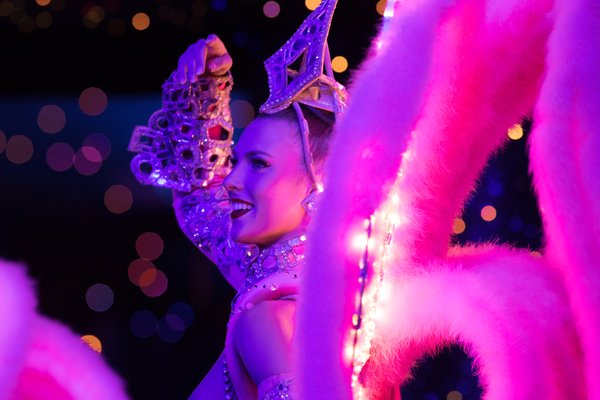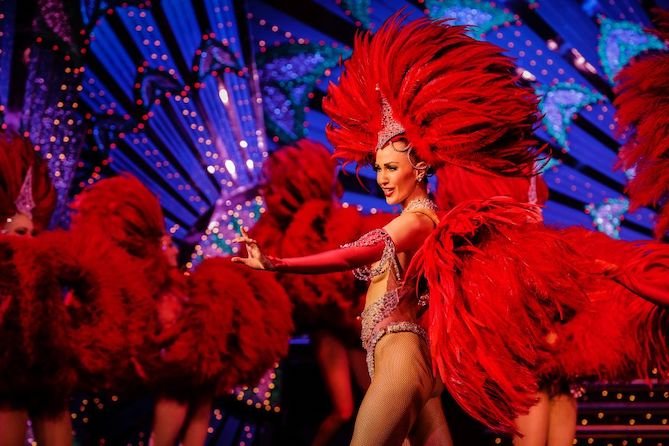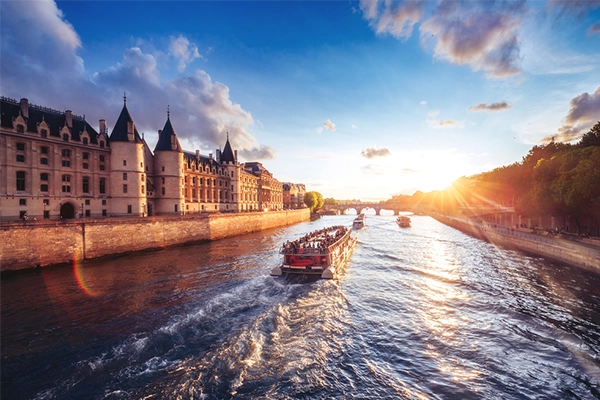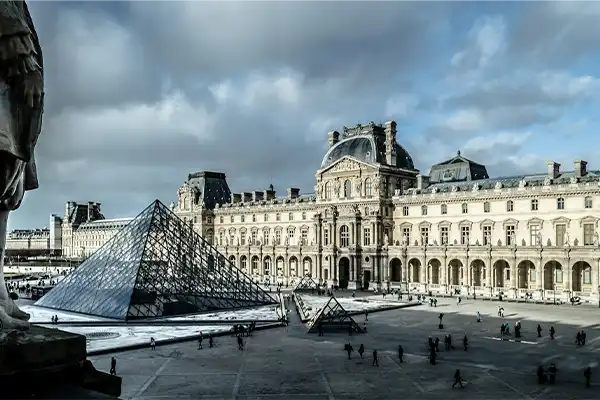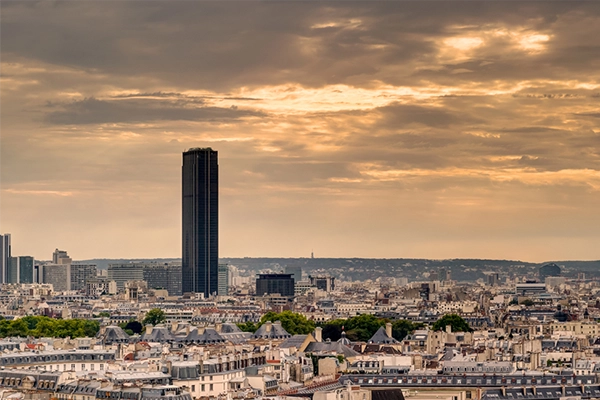Ultimate Guide to Moulin Rouge: Current Show, Tickets & More
Ultimate Guide to Moulin Rouge: Current Show, Tickets & More
Prepare for an enchanting visit of Moulin Rouge with our complete Moulin Rouge guide. On this page, get acquainted with the dinner and show times, find straightforward directions, and access valuable traveler tips.
Receive insightful recommendations on attire, recommended restaurants nearby, and read about the history as well as fun facts. Dive into a diverse selection of ticket options to ensure a seamless and unforgettable experience awaits you.
Let’s start with general information about Moulin Rouge and its current show.
That’s Moulin Rouge
When it comes to cabaret in Paris, the first thing that comes to mind is the world-famous Moulin Rouge, with its distinctive red windmill symbol, a legendary spot of Parisian nightlife and an indispensable piece of the city’s rich cabaret history. It is the oldest continuously operating cabaret and is considered to be the place that helped the legendary cancan go worldwide.
Since its opening on October 6, 1889, Moulin Rouge has provided a fascinating stage for international artists and is famous for its extravagant shows, which delight with colorful costumes, sparkling sets and talented dancers.
The elaborate performances are a breathtaking mix of music, dance and dramatic art. Moulin Rouge also has a long tradition of dinner shows, where guests can enjoy a fine French menu while being enchanted by the spectacular show.

About the Current Show “Féerie”
“Féerie”, created by Doris Haug and Ruggero Angeletti, has been captivating audiences at the Moulin Rouge since 1999. This spectacular cabaret showcases a troupe of 80 artists, including 60 Doriss Girls recruited globally.
The show boasts over 1,000 vibrant costumes adorned with feathers, rhinestones, and sequins, crafted in renowned Parisian workshops. These elaborate costumes are a dazzling highlight of the performance. In addition, the stage features phenomenal sets by Italian artists, a giant aquarium hosting an aquatic ballet, and remarkable international acts.
With an original musical score composed by Pierre Porte and Roland Léonar, performed by a team of 80 musicians and 60 chorus singers, a visit to the Moulin Rouge is a sensory feast!
Moulin Rouge Dinner & Show Times
Dinner time: Daily 7 pm
Show times: Daily 9 pm and 11 pm
Moulin Rouge Location and Directions
Address: Moulin Rouge, 82 Boulevard de Clichy, 75018 Paris
Find on Google maps: Moulin Rouge
How to get to Moulin Rouge
By Metro
Line M2 Blanche station and 1 minute on foot
Line M12 Pigalle station and 5 minutes on foot
Line M13 Place de Clichy station and 5 minutes on foot
By Bus
Lines 30, 54 Blanche stop and 1 minute on foot
Lines 68, 74 Blanche-Calais stop and 3 minutes on foot
Lines 80, 95 Place de Clichy-Caulaincourt stop and 5 minutes on foot
line 21 Place de Clichy stop and 5 minutes on foot
Line 40 Pigalle stop and 5 minutes on foot
4 Traveler Tips for Visiting Moulin Rouge

Quick Facts about Moulin Rouge

- Address: Moulin Rouge, 82 Boulevard de Clichy, 75018 Paris
- Founders: Joseph Oller and Charles Zidler
- Construction: 1889
- Architects: Adolphe Willette and Édouard-Jean Niermans
- Architectural Style: Belle Époque
- Capacity of the main hall: 850 people
- Premiere: October 6, 1889
- Number of Visitors per Year: 600,000
9 Fun Facts about the Moulin Rouge Cabaret in Paris
1. Spreading The Fame Of Cancan
The Moulin Rouge is credited with popularizing the cancan dance, known for its high kicks and energetic movements. The dance style originated in the working-class ballrooms of Montparnasse but gained fame and notoriety at the Moulin Rouge.
2. Elephant İn The Garden
In the early years, the Moulin Rouge had a massive mechanical elephant in its garden. The elephant, designed by Charles Zidler and Joseph Oller (the founders of Moulin Rouge), could carry passengers on its back and housed a bar and a piano inside.
3. First Elevator İn Montmartre
Moulin Rouge was one of the first places in Montmartre to have an elevator. It was a technological marvel at the time, allowing visitors to easily access the dance hall on the first floor.
4. Artists’ Retreat
During World War II, German officers frequented the Moulin Rouge. However, the cabaret remained a gathering place for members of the French Resistance. The legend goes that when the Germans entered, the performers would change the lyrics of their songs to mock the occupiers.
5. Birthplace Of Striptease
While the cancan was the highlight, the Moulin Rouge is also considered one of the birthplaces of striptease. In the early 20th century, performers at the Moulin Rouge would sometimes end their acts by tossing off a piece of clothing.
6. Artistic Innovations
Artists like Henri de Toulouse-Lautrec and Edgar Degas were regulars at the Moulin Rouge. Toulouse-Lautrec, in particular, created iconic posters for the cabaret that have become synonymous with the Belle Époque, a period of artistic and cultural flourishing in France from the late 19th century to the early 20th century.
7. Movie Backdrop
Moulin Rouge has been featured in numerous films, including the 1928 silent film “The Kiss”, starring Douglas Fairbanks and Mary Pickford, the 1952 Hollywood musical “An American in Paris”, starring Gene Kelly and Leslie Caron, the 1954 French-Italian co-production “French Can Can”, starring Jean Gabin and Françoise Arnoul, reflecting the founding period of Moulin Rouge, the 1964 French release “The Umbrellas of Cherbourg”, starring Catherine Deneuve and Nino Castelnuovo, the 1968 heist movie “The Thomas Crown Affair”, starring Steve McQueen and Faye Dunaway, the 2001 musical film drama “Moulin Rouge!”, starring Nicole Kidman and Ewan McGregor, and the 2011 Woody Allen stripe “Midnight in Paris”, starring Owen Wilson and Rachel McAdams.
8. Lots Of Stars İn The Audience
Moulin Rouge has hosted a star-studded clientele, including the likes of Ernest Hemingway, Charlie Chaplin, Josephine Baker, Frank Sinatra and Elton John. These renowned figures have added to the cabaret’s allure and contributed to its reputation as a haven for the fashionable and elite.
9. Some Numbers
Moulin Rouge’s stage is 13 meters (43 feet) deep and 18 meters (59 feet) wide, making it one of the largest cabaret stages in the world. The shows feature over 100 costumes, which are designed and made by hand, and use over 1,000 Swarovski crystals, which are hand-placed onto the costumes and sets.
History of Moulin Rouge
1889: Moulin Rouge opens
Joseph Oller and Charles Zidler, two businessmen, open the Moulin Rouge at 82 Boulevard de Clichy, at the foot of the Butte Montmartre. Premiere is on October 6, 1889.
The cabaret is named after a local windmill, which was once a popular spot for artists and writers.
1890s: Rise to Prominence
Moulin Rouge quickly becomes a popular destination for Parisians and visitors alike, thanks to its lively atmosphere and glamorous shows.
Hosting its first major event: Moulin Rouge hosts its first major event, the Bal des Quat’z’Arts, a student masquerade ball that that causes a scandal with its display of nudity, but attracts a large crowd of artists and art students.
Marked by elaborate costumes and decorations: The Bal des Quat’z’Arts is known for its elaborate costumes and decorations, solidifying Moulin Rouge’s reputation as a place of excitement and pleasure.
1897, Moulin Rouge is closed temporarily for the funeral of its co-founder, Charles Zidler. His death is a major loss for the Moulin Rouge, as he was a charismatic and visionary leader.
The cabaret reopens and becomes a popular attraction for tourists during the Exposition Universelle, the World’s Fair 1900 held in Paris.
1900s: Belle Époque Glamour
Amidst the Belle Époque: Joseph Oller introduces new shows and attractions to keep the Moulin Rouge fresh and exciting for its patrons. The cabaret continues to flourish in the Belle Époque, a period of economic growth and cultural innovation.
The popularity of the quadrille, which has roots dating back to the 1820s and is known as the French Cancan dance, is increasing. The incredible linen girls of Montmartre Hill enter the stage and are amazed by the audience. For them, the Cancan is an opportunity to question the existing order. Some of them become iconic characters. The energetic dance becomes one of the cabaret’s signature performances.
Hosting renowned entertainers: Moulin Rouge hosts renowned entertainers like Maurice Chevalier, Aristide Bruant, La Goulue, and Jane Avril, further cementing its position as a Parisian icon.
Serving as a backdrop for artistic movements: Moulin Rouge becomes a muse for artists, writers, and photographers, inspiring works like Henri de Toulouse-Lautrec’s iconic posters.
1910s: War and Resilience
Surviving the challenges of World War I: Moulin Rouge navigates the challenges of World War I, keeping its doors open despite the disruptions caused by the conflict.
Maintaining its allure during the war: The cabaret continues to attract audiences, even during wartime, showcasing the resilience of Parisian culture.
Celebrating the war’s end: After the war’s conclusion, Moulin Rouge becomes a focal point for Parisians celebrating peace.
Embracing new entertainment forms: The cabaret begins to experiment with new forms of entertainment, such as revues and “comédies musicales”, to keep its audience engaged.
In 1915, a fire, caused by a faulty electrical system, destroys the cabaret’s main building. However, Oller is determined to rebuild the Moulin Rouge, and he quickly raises funds to finance the reconstruction.
Moulin Rouge reopens after a four-year closure. The new Moulin Rouge is even grander and more spectacular than the original, with a larger stage, a more elaborate set, and a wider variety of performances.
The cabaret quickly regains its popularity with Parisians and visitors alike, and it continues to be a major tourist attraction in Paris today.
One of the most famous performers of the 1910s is La Goulue, the original “Queen of Cancan”, known for her provocative style and infectious energy.
1920s The Jazz Age
The 1920s are a time of great social and cultural change, and Moulin Rouge reflects this with its jazz-infused performances, flapper dresses, and relaxed atmosphere.
The cabaret’s shows become more daring and provocative, and they often feature new dance styles, such as Charleston and Tango.
One of the most famous performers of the 1920s is Josephine Baker, who is known for her exotic costumes and energetic performances.
1930s: Adapting to the Great Depression
Economic Depression: The Great Depression hit the Moulin Rouge hard, and the cabaret struggles to attract audiences.
Survival strategies: Moulin Rouge introduces new shows and attractions to appeal to a wider audience, and it also begins hosting banquets and private parties.
Cultural significance: Despite the economic challenges, Moulin Rouge remaines a popular destination for Parisians and tourists alike, and it continues to be a symbol of the city’s vibrant nightlife.
One of the most popular performers of the 1930s is Mistinguett, renowned for her comedic routines and her ability to connect with the audience.
1940s: Reflowering Amidst Conflict
World War II: Moulin Rouge is forced to close during the German occupation of Paris and reopens in 1945, after liberation of the city by the Allied forces.
Post-war recovery: After the war, Moulin Rouge experiences a resurgence of popularity, and it became a focal point for Parisians celebrating the end of the conflict.
New directions: Moulin Rouge begins to experiment with new forms of entertainment, such as revues and “comédies musicales”, attracting a wider audience from all over the world.
One of the most popular performers of the 1940s is Yves Montand, who is known for his powerful vocals and his charismatic stage presence.
1950s: Resurgence and Expansion
Major Renovation: The Moulin Rouge undergoes a major renovation in the 1950s, expanding its stage and introducing new lighting and sound systems.
Rebirth of Grandeur: This period saw the return of the Moulin Rouge to its former glory, attracting a wider audience and solidifying its position as a landmark of Parisian culture.
Embracing Change: The cabaret also embraces the changing cultural trends of the time, introducing new performances that incorporate music, dance, and comedy.
One of the most popular performers of the 1950s is legendary dancer Fred Astaire, renowned for his signature style of elegance and precision.
1960s: Adapting to the Swinging Sixties
Evolving Spectacle: Moulin Rouge continues to evolve and adapt to the changing tastes of the times in the 1960s, introducing new revue-style shows that incorporate the music and dance of the Swinging Sixties.
Countercultural Symbol: Moulin Rouge’s iconic red windmill becomes an enduring symbol of the 1960s counterculture.
Performance Innovations: The cabaret introduced new elements to its performances, incorporating elements of fashion, art, and technology, further enhancing the spectacle and creating a truly immersive experience for audiences.
The Beatles make a guest appearance at the Moulin Rouge in 1964, during their world tour. They are invited by the cabaret’s management to attend a private performance and meet the dancers. The world-famous band is reportedly impressed by Moulin Rouge’s spectacle and enjoy their time at the cabaret.
The King of Rock and Roll, Elvis Presley, follows in 1965. He performs at Moulin Rouge during his first European tour.
1970s: Celebrating a Century of Spectacle
Advancing Entertainment: The cabaret continues to produce lavish and spectacular shows, incorporating the latest trends in music, dance, and technology.
Diversifying Audience: Moulin Rouge’s appeal extends beyond Parisians, attracting a diverse clientele from around the world, reflecting the cabaret’s global reach and enduring popularity.
Centenary Celebrations: In 1979, Moulin Rouge celebrates its 100th anniversary, marking a century of dazzling performances and captivating audiences.
Serge Gainsbourg: The French singer-songwriter and provocateur is a regular performer at the Moulin Rouge. His performances are known for their raw energy, sexual energy, and witty lyrics, often blurring the lines between cabaret and performance art.
Charles Aznavour: The iconic French singer and songwriter performs multiple times throughout the 1970s. His romantic ballads and soulful vocals are resonating with audiences, and he becomes a beloved fixture at the cabaret.
David Bowie: The enigmatic rock star performs in 1974, as part of his “Diamond Dogs” tour. His performance is a theatrical spectacle, blending his signature glam rock style with elements of cabaret and circus.
1980s: Maintaining Star Status
Renaissance of Glamour: The Moulin Rouge continues to draw crowds with its extravagant shows and glamorous atmosphere.
International Appeal: The cabaret attracts a global clientele, including celebrities, dignitaries, and commoners alike.
Fashion Collaborations: The Moulin Rouge collaborates with renowned fashion designers to create stunning costumes for its shows.
Diverse Performances: The cabaret showcases a variety of performances, including ballet, magic, and acrobatics.
Sylvie Vartan: The French pop singer and actress performed at the Moulin Rouge multiple times throughout the 1980s. Her energetic performances and catchy tunes resonated with audiences, and she became a beloved fixture at the cabaret.
Shirley MacLaine: The iconic actress and singer graced the Moulin Rouge stage in 1985, starring in a production of “La Vie Parisienne.” Her performances were known for their elegance, sophistication, and her ability to connect with audiences on a personal level.
Liza Minnelli: The iconic American singer and actress made a memorable appearance at the Moulin Rouge in 1988, performing a medley of her greatest hits.
1990s: Reasserting Parisian Panache
Fashion Collaborations: Partnerships with prominent fashion designers, such as Christian Dior and Jean Paul Gaultier, elevate the cabaret’s visual spectacle and elevate the Moulin Rouge to a new echelon of fashion iconology.
Immersive Experiences: The Moulin Rouge incorporates cutting-edge technology into its performances, creating immersive and captivating experiences that blur the boundaries between stage and audience.
Sade, famous British singer-songwriter, delivers a captivating performance in 1994, as part of her “Love Deluxe” tour.
Whitney Houston, American superstar, gives a memorable performance in 1998, as part of her “My Love Is Your Love” tour.
In 1999, Moulin Rouge celebrates its 110th anniversary with a grand gala event.
2000s to present: Flourishing in the New Millennium
Christina Aguilera (2000), Lady Gaga (2010), Beyoncé (2011), Britney Spears (2020) and Ed Sheeran (2022) perform, to name just a few of the stars who take the stage at the Red Mill.
Moulin Rouge continues to attract hundreds of thousands of visitors each year, and it remains one of the most iconic and beloved landmarks in Paris.
3 Best Places to Eat near Moulin Rouge
Have you decided on a show without dinner, but still want to have a delicious meal before or after the burlesque show?
We have selected three restaurants for you with good Google reviews, very close to Moulin Rouge. Whether relishing the timeless essence of French cuisine or indulging in international culinary creations, these restaurants promise a diverse array of dining experiences, enhancing your visit to the cabaret show.
Tip: For local tips on romantic dining spots, read our article, 7 Romantic Restaurants for a Date in Paris.
Tickets for Moulin Rouge Cabaret in Paris
Explore a thoughtfully selected collection of tickets tailored to elevate your Moulin Rouge experience, as well as other popular cabarets in Paris.
>> Compare all options with our comparison table and pick the best ticket.
>> Don’t miss our detailed guide on Paradis Latin, covering show times, information, directions, and more.
Images ©Moulin Rouge



